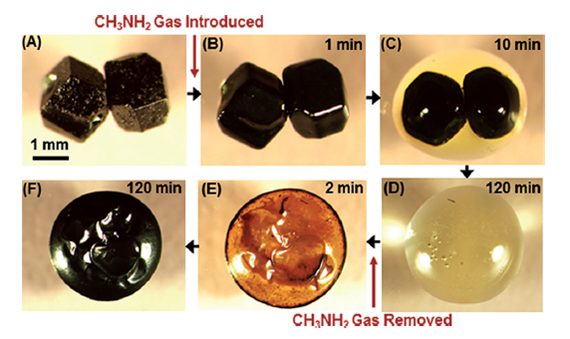
Owing to their unique optical, electric and magnetic properties as well as simple preparation and inexpensive fabrication routes, organolead halide perovskites have become an attractive light-absorber with a rapid improvement of efficiencies from 3.8% in 2009 to a certified 20.1% up to the present. As core parts, the formation of high-quality perovskite thin films highly affects the performance of the devices mentioned above and hence it is of great significance for deeper research in gaining better control over the crystallization of perovskite from solution.
Recently, the Biomimetics for Energy Storage Group led by Prof. CUI Guanglei at Qingdao Institute of Bioenergy and Bioprocess Technology (QIBEBT) of the Chinese Academy of Sciences, cooperating with Prof. Nitin P. PADTURE in Brown University and Dr. FAN in Weihua Solar Co., Ltd. successfully addressed this issue by a developed room-temperature, ultrafast methylamine-induced defect-healing (MIDH) technology.
Central to this unprecedented healing behavior is the unusual chemical interaction between MAPbI3 perovskite and methylamine (CH3NH2) gas as shown in Figure 1. When CH3NH2 gas is introduced, the MAPbI3 perovskite particle starts to smooth and the surface of MAPbI3 perovskite crystals appear to “melt” after a few minutes. Later the MAPbI3 perovskite crystals full collapse into liquid.
Soon after the melt-process, the MAPbI3 perovskite recrystallizes along with the darkening of the liquid. Upon reduction of CH3NH2 gas partial pressure, CH3NH2 molecules are released from the liquid, resulting in the reconstruction of the MAPbI3 perovskite structure. Based on this technology, by treating the rough perovskite films, a high quality perovskite film could be easily obtained and result in a considerable improvement of the device efficiency.
This work was published in Angewandte Chemie International Edition. This self-healing behavior of the perovskite materials is fresh new and extremely attractive to materials science researchers and is ready for large scale production. Figure 1. In situ optical microscopy of the morphology evolution of two touching MAPbI3 perovskite crystals (same magnification) upon exposure to CH3NH2 gas and CH3NH2 degassing: (A) before CH3NH2 gas exposure, (B) CH3NH2 gas introduced, (C) partial collapse of perovskite structure and conversion to liquid, (D) full conversion to liquid, (E) CH3NH2 degassing, and (F) perovskite back-conversion completed. (Image by QIBEBT)


86-10-68597521 (day)
86-10-68597289 (night)

86-10-68511095 (day)
86-10-68512458 (night)

cas_en@cas.cn

52 Sanlihe Rd., Xicheng District,
Beijing, China (100864)

